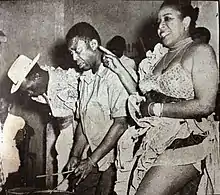Silvano "Chori" Shueg
Silvano Shueg Hechevarría (January 6, 1900 – April 1974), better known as Chori or Choricera, was a famous Cuban percussionist. He rose to prominence in the 1930s due to his extravagant shows at many nightclubs in Havana where he played timbales, drums, cowbells and objects such as bottles and metal pans. He composed the popular sones "La choricera" and "Ayaca de maíz", and appeared in several films in the 1950s.
Silvano "Chori" Shueg | |
|---|---|
 Chori playing timbales, 1950. | |
| Background information | |
| Birth name | Silvano Shueg Hechevarría |
| Also known as | Choricera |
| Born | January 6, 1900 Santiago de Cuba, Cuba |
| Died | April 1974 (aged 74) Havana, Cuba |
| Genres | Son cubano, guaracha |
| Occupation(s) | Musician |
| Instrument(s) | Timbales, drums, cowbell, bottles, pans, boxes |
Life and career
Early years
Silvano Shueg Hechevarría was born on January 6, 1900, in Santiago de Cuba, the capital of Oriente, Cuba's easternmost region.[1][2][3] In 1919 Shueg became the timbalero in a son estudiantina (student ensemble) from Santiago called Los Champions del Son.[4][5] In 1927, the band toured Havana and Shueg decided to stay in the city, where he joined the Marte y Belona dance academy.[6][7] He then began performing at the numerous nightclubs and cabarets along the beach in Marianao, such as Los Tres Hermanos, El Ranchito, Rumba Palace (which was renamed La Choricera in his honor), and La Taberna de Pedro, where he played for over a decade.[7][8] In these venues he met other percussionists including Cándido Camero[9] and Tito Puente.[6][10] He played sones and guarachas, and occasionally sang through a megaphone.[11]
Rise to fame
Shueg quickly became a popular act in Havana's nightlife, partially as result of his self-promotion through graffiti that he sketched on streets and trains.[3][11] In addition, American journalist Drew Pearson contributed to Shueg's popularity by mentioning him in his column.[12] He composed two sones, "La choricera" and "Ayaca de maíz", that became very popular.[3][11] Miguelito Valdés invited him to play at the Sans Souci, but the Musicians's Guild rejected him and Shueg went back to the nightclubs on the shoreline.[8] In 1955 he took part in the Mexican film Un extraño en la escalera, and in 1956 Marlon Brando went to see him during his visit to Havana, ultimately failing to bring Shueg to the United States (Shueg left the airport minutes before his flight).[8][13] Two years later, Errol Flynn attended one of Shueg's performances and offered him a role in the film The Big Boodle, which he accepted.[8] Many other celebrities attended his performances in Havana between the 1930s and 1950s, including Langston Hughes,[14] Toña la Negra, Agustín Lara, Cab Calloway, and Ernest Hemingway,[7][8][10] and he was featured in Life magazine.[11][15]
Later years and death
In 1961, Shueg appeared in the cinéma vérité short film PM, the first film to be banned in Castro's regime.[16] Starting in 1962, Shueg would often perform at a peña (a venue) where veteran musicians and trovadores such as Sindo Garay would play.[8] These concerts were organized by Alfredo González Suazo, better known as Sirique, who named the band Los Tutankamén.[17] In 1966, Shueg and the rest of the group appeared in the documentary La herrería de Sirique.
Shueg died in April 1974 in Havana.[3] In 2001, Cuban poet Ramón Fernández-Larrea wrote a piece in Shueg's memory.[18]
Filmography
- 1955: Un extraño en la escalera
- 1958: The Big Boodle
- 1961: PM (Pasado Meridiano)
- 1966: La herrería de Sirique
References
- Campoamor, Fernando G. (April 1966). "Chori". Bohemia (in Spanish). 58 (13): 24–27.
- Mestas, María del Carmen (1998). Pasión de rumbero (in Spanish). Barcelona, Spain: Puvill Libros. p. 126.
- Orovio, Helio (2004). Cuban Music from A to Z. Bath, UK: Tumi. p. 201. ISBN 9780822385219.
- Dalmace, Patrick. "El Chori". Montuno Cubano (in French). Retrieved October 3, 2015.
- Dalmace, Patrick. "Los Champions del Son". Montuno Cubano (in French). Retrieved October 3, 2015.
- Powell, Josephine (2007). Tito Puente: When the Drums Are Dreaming. Bloomington, IN: Authorhouse. pp. 222–225. ISBN 9781452072746.
- Moore, Robin (1997). Nationalizing Blackness: Afrocubansimo and Artistic Revolution in Havana, 1920-1940. Pittsburgh, PA: University of Pittsburgh Press. p. 184. ISBN 9780822971856.
- Padura, Leonardo (2014). "Chori. Vida, pasión y muerte del más celebre timbalero cubano". El viaje más largo (in Spanish). Barcelona, Spain: NED Ediciones. ISBN 9788494236433.
- Sanabria, Bobby (October 6, 2011). "Candido: Father of Modern Conga Drumming". DRUM! Magazine. Retrieved October 3, 2015.
- Conzo, Joe; Pérez, David A. (2010). Mambo Diablo: My Journey With Tito Puente. Bloomington, IN: Authorhouse. pp. 203–204. ISBN 9781452082813.
- Ledón Sánchez, Armando (2003). La música popular en Cuba (in Spanish). Oakland, CA: Intelibooks. p. 57. ISBN 9780932367150.
- Suárez Hernández, Senén (March 15, 2004). "¿Quién fue el Chori?". Cubarte (in Spanish). Retrieved October 3, 2015.
- Forteza, Francisco (June 2, 2014). "Marlon Brando fue el "señor de las congas"". Cuba sí. Retrieved October 3, 2015.
- Guillén, Nicolás (1982). Páginas vueltas. Havana, Cuba: Ediciones Unión. pp. 105–106.
- Orejuela, Adriana (2006). El son no se fue de Cuba (in Spanish). Havana, Cuba: Letras Cubanas. p. 151.
- Stock, Ann Marie (2014). World Film Locations: Havana. Chicago, IL: Intellect Books. p. 28. ISBN 9781783201976.
- Betancourt, Lino (October 26, 2011). "La peña de Sirique". Cubarte (in Spanish). Retrieved October 3, 2015.
- Fernández Larrea, Ramón (June 18, 2001). "Carta al Chori". Cubaencuetro (in Spanish). Retrieved October 3, 2015.
Further reading
- Quiroga, Orlando (October 8, 1961). "La Habana noche tras noche". Bohemia (in Spanish). 53 (41): 98.
- Tamargo, Luis (November 1, 2001). "Timbal icons from Havana to New York and beyond". Latin Beat Magazine. Archived from the original on February 24, 2016.